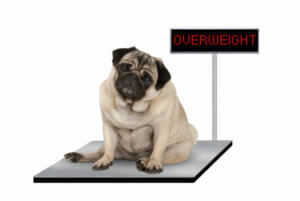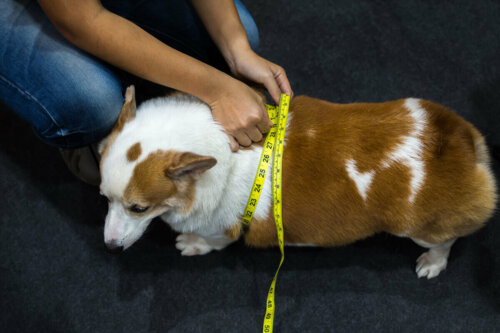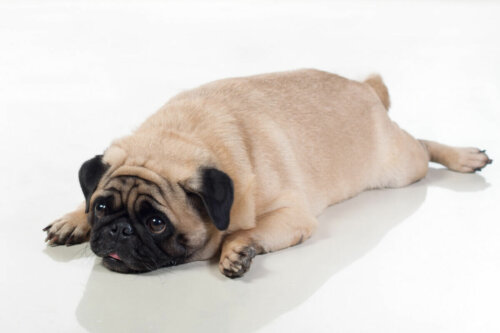Types of Treatment for Overweight Dogs


Written and verified by the vet Juan Pedro Vazquez Espeso
It may seem strange to hear there’s treatment for overweight dogs, but it’s quite common, in fact. This is because these types of disorders can severely damage the general health of an animal. Thus, you must consult a vet to obtain a proper diagnosis.
Nevertheless, this is easier said than done as canine overweight isn’t usually perceived as an illness. However, it’s one of the most frequent reasons to consult a veterinarian.
Today’s article will describe how one can manage this condition and the method to achieve an optimal body condition for overweight dogs. Of course, it’ll improve their quality of life.
Why are some dogs overweight?
Obesity is an accumulation of excess body fat that affects the functionality of their physiological mechanisms. It also predisposes them to the development of certain illnesses. Unfortunately, eating disorders are quite common in pets and, thus, sort of normal.
The evaluation of the body condition of a dog is somewhat complex. However, one can evaluate it in two ways:
- An excess of weight of around 30-40% with respect to their type denotes an eating disorder
- The inability to feel the dog’s ribs indicates the animal is overweight

Nutritional management of overweight dogs
One of the basic pillars of the management of this condition has a simple premise: the calories ingested must be less than the calories spent. Thus, excess energy will accumulate in the form of fat in the adipose tissue when a dog ingests more calories than its body consumes throughout the day.
After this little lesson about nutrition and metabolism, you can deduce you’ve got to modify the quantity and quality of food you give to your pet. Here are some ways to tackle this problem.
1. Administer low-calorie feed
This type of feed provides the animal with a limited caloric contribution without modifying the rest of the components. In other words, a low-calorie feed constitutes a complete and balanced diet a dog can consume in the long term.
In addition, it satiates the animal so they easily lose weight without being hungry.
Unfortunately, these types of food are usually less palatable for the animal due to their low-fat composition. This means picky dogs won’t like them.
2. Reducing the amount of feed
This measure can be effective, especially for those picky eaters. However, it isn’t recommended in the long term as it can lead to nutritional deficiencies in the animal.
3. Go easy on the treats
Food between meals, such as jelly beans or cookies and bread are high-calorie elements that quickly lead to obesity. It’s for this reason that you must avoid them entirely or just go easy on them if you offer them frequently.
Include exercise as part of the treatment for overweight dogs
An active dog burns more of the calories it consumes and stays thinner. Logically, this therapy has to be adapted to every pet and their particular needs. For example, don’t force an obese dog to run a marathon every day.
Physical activity must be moderate at the beginning so start with short walks. Then, try increasing the frequency and intensity as the animal gains more resistance and begins to lose weight.
The dog doesn’t have to become an accomplished athlete. Being able to chase a ball without losing their breath will suffice during the first stages of their new exercise routine.
Educating the owner
This may just be the most complex treatment as it’s often difficult to make a dog’s human understand that obesity is a dangerous illness.
Thus, people must know that a chubby dog isn’t a happy dog as this is the cornerstone of therapy. Furthermore, owners must do their best to help their animals lose weight.
You’re probably aware of how hard it is to deny your dog a treat, especially when they look at you with those super cute puppy eyes that seem to claim “nobody ever gives me anything.” However, you must understand it’s not the right type of food for them. Remember, treating obesity requires discipline.

In short, we hope you understand that an overweight dog is ill and so you must change their habits in order for them to reach their optimal weight.
It may seem strange to hear there’s treatment for overweight dogs, but it’s quite common, in fact. This is because these types of disorders can severely damage the general health of an animal. Thus, you must consult a vet to obtain a proper diagnosis.
Nevertheless, this is easier said than done as canine overweight isn’t usually perceived as an illness. However, it’s one of the most frequent reasons to consult a veterinarian.
Today’s article will describe how one can manage this condition and the method to achieve an optimal body condition for overweight dogs. Of course, it’ll improve their quality of life.
Why are some dogs overweight?
Obesity is an accumulation of excess body fat that affects the functionality of their physiological mechanisms. It also predisposes them to the development of certain illnesses. Unfortunately, eating disorders are quite common in pets and, thus, sort of normal.
The evaluation of the body condition of a dog is somewhat complex. However, one can evaluate it in two ways:
- An excess of weight of around 30-40% with respect to their type denotes an eating disorder
- The inability to feel the dog’s ribs indicates the animal is overweight

Nutritional management of overweight dogs
One of the basic pillars of the management of this condition has a simple premise: the calories ingested must be less than the calories spent. Thus, excess energy will accumulate in the form of fat in the adipose tissue when a dog ingests more calories than its body consumes throughout the day.
After this little lesson about nutrition and metabolism, you can deduce you’ve got to modify the quantity and quality of food you give to your pet. Here are some ways to tackle this problem.
1. Administer low-calorie feed
This type of feed provides the animal with a limited caloric contribution without modifying the rest of the components. In other words, a low-calorie feed constitutes a complete and balanced diet a dog can consume in the long term.
In addition, it satiates the animal so they easily lose weight without being hungry.
Unfortunately, these types of food are usually less palatable for the animal due to their low-fat composition. This means picky dogs won’t like them.
2. Reducing the amount of feed
This measure can be effective, especially for those picky eaters. However, it isn’t recommended in the long term as it can lead to nutritional deficiencies in the animal.
3. Go easy on the treats
Food between meals, such as jelly beans or cookies and bread are high-calorie elements that quickly lead to obesity. It’s for this reason that you must avoid them entirely or just go easy on them if you offer them frequently.
Include exercise as part of the treatment for overweight dogs
An active dog burns more of the calories it consumes and stays thinner. Logically, this therapy has to be adapted to every pet and their particular needs. For example, don’t force an obese dog to run a marathon every day.
Physical activity must be moderate at the beginning so start with short walks. Then, try increasing the frequency and intensity as the animal gains more resistance and begins to lose weight.
The dog doesn’t have to become an accomplished athlete. Being able to chase a ball without losing their breath will suffice during the first stages of their new exercise routine.
Educating the owner
This may just be the most complex treatment as it’s often difficult to make a dog’s human understand that obesity is a dangerous illness.
Thus, people must know that a chubby dog isn’t a happy dog as this is the cornerstone of therapy. Furthermore, owners must do their best to help their animals lose weight.
You’re probably aware of how hard it is to deny your dog a treat, especially when they look at you with those super cute puppy eyes that seem to claim “nobody ever gives me anything.” However, you must understand it’s not the right type of food for them. Remember, treating obesity requires discipline.

In short, we hope you understand that an overweight dog is ill and so you must change their habits in order for them to reach their optimal weight.
All cited sources were thoroughly reviewed by our team to ensure their quality, reliability, currency, and validity. The bibliography of this article was considered reliable and of academic or scientific accuracy.
- ATLAS DE NUTRICIÓN Y ALIMENTACIÓN PRÁCTICA EN PERROS Y GATOS. VOL UMEN II
This text is provided for informational purposes only and does not replace consultation with a professional. If in doubt, consult your specialist.








